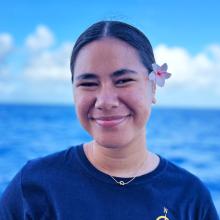
Talofa Fe'a
Tell us about your work/research. What kinds of things do you do?
At this stage in my undergraduate career, my work and research have predominantly focused on integrating traditional knowledge with modern datasets and collection methods. For NOAA’s Center for Operational and Oceanographic Products and Services (CO-OPS), I developed an ArcGIS StoryMap that combined community experiences with water level data from the Hunga Tonga–Hunga Haʻapai eruption in January 2022. At the National Marine Sanctuary of American Samoa, I conducted interviews and surveys with local fishers and consumers to gather baseline information on ciguatera poisoning, identifying high-risk locations and species in American Samoa. Essentially, I explore how local knowledge can be applied to efforts addressing contemporary environmental and scientific issues. This involves collaborating with community members to gather their insights and then translating these findings into accessible and impactful formats, such as reports, factsheets, presentations, and visualizations. By bridging the gap between traditional perspectives and modern empirical data, my goal is to enhance understanding and support informed decision-making in environmental management and conservation.
What sparked your initial interest in your career?
My initial interest in Pacific Island environmental research and management was sparked by my upbringing as a tama'ita'i Samoa. The values and traditions of my community, which emphasize a reciprocal relationship with the environment, instilled in me a deep respect for nature and a commitment to preserving it. This passion was further validated through science fair projects, environmental education programs, and similar experiences. With environmental changes and disasters increasingly threatening our Pacific Island communities, maintaining this passion for our lands and seas has never been more important to me. These challenges only strengthen my resolve to pursue a career in conservation and restoration, ensuring that we protect and sustain our precious natural resources for future generations.
Who influenced you or encouraged you the most?
Born and raised in American Samoa, the encouragement I receive from my village and home community has been the most influential. This includes my family, educators, and all the generations of environmental stewards and Pasefika scientists—both past and present, as well as those who will follow. Their support and legacy inspire me deeply and drive me to contribute meaningfully to our shared environmental goals.
What element of your work/study do you think is the most fascinating?
I find the intersection of traditional knowledge and modern scientific research to be the most fascinating aspect of my work. I am consistently amazed by the depth of scientific understanding that Pacific Island community members possess and live daily. Through methods that allow me to engage in conversations with them, I see firsthand the invaluable insights they offer about our environment. For this reason and more, I am always striving to honor their knowledge by amplifying their voices, advancing their needs, and recognizing their expertise in any research/work I conduct.
How did you get involved with the Ocean Exploration Trust?
This summer, I worked with the National Marine Sanctuary of American Samoa science team as a NOAA EPP/MSI scholar/intern. Through a connection facilitated by my mentor, Research Coordinator Val Brown, I was introduced to Dr. Daniel Wagner, Chief Scientist at Ocean Exploration Trust. This led to my involvement with the 2024 E/V Nautilus Expedition science team. I’m truly grateful for the opportunity and the support that made it possible.
What other jobs led you to your current career?
Throughout my undergraduate studies, I have engaged in various experiences that have shaped my current ambition to advance the needs of Oceania through STEM. Currently, I work as an undergraduate research assistant for the University of Hawaii Sea Grant College Program, supporting the Pacific Ciguatera Network project. I also serve as a student assistant for the Telecommunications and Social Informatics (TASI) Research Program at UHM, contributing to the Pacific International Training Desk project. Additionally, I am a research event coordinator assistant for the UHM ADVANCE Catalyst Research Team, where I help support the team’s efforts to advance kaulike (equity) by focusing on STEM intersectional experiences at the institution.
These roles, among others, have significantly solidified my interest in resource management and reinforced my aspirations to work with Pacific Island communities.
What are your degrees and certifications?
Associate of Science in Natural Resources — American Samoa Community College 2022;
Bachelor of Science in Natural Resources and Environmental Management — University of Hawaiʻi at Mānoa 2024
What are your hobbies?
In my free time, I enjoy snorkeling and hiking. I also find fulfillment in participating in community workdays, where I can give back and make a positive impact. On some days, though, there’s nothing better than doing nothing and taking a good nap to recharge.
What advice would you give someone who wants to have a career like yours?
Unfamiliarity ≠ Incapability. It’s natural to feel uncertain or intimidated when faced with new concepts, technologies, or fields of study. However, you must remember that not knowing something right away doesn’t mean you’re not capable of learning and mastering it. In essence, think “Unfamiliarity = Opportunity” — the opportunity to learn something new, connect with experts, and expand your skill set.
Expeditions
Talofa participated in the following Ocean Exploration Trust expeditions:

